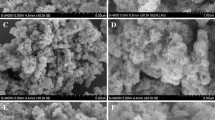Abstract
A simple and controllable fabrication of TiO2 nanowires by electrospinning and their applications to the electron transporting layer for hybrid organic–inorganic photovoltaic cells are reported. TiO2 nanowires were directly electrospun onto an indium tin oxide on glass substrate from a solution in methanol of polyvinylpyrrolidone, titanium(IV) butoxide, and acetylacetone. The nanowire electrode obtained was consequently subjected to calcination at 450 °C. Solution of blended [6,6]-phenyl-C61-butyric acid methyl ester and poly(3-hexylthiophene) was spin coated on the TiO2 nanowire electrode, followed by thermal annealing and deposition of Au electrode. Hybrid organic–inorganic photovoltaic cells made of TiO2 nanowires exhibited remarkable improvement of the cell efficiencies in terms of photocurrent density and open-circuit voltage as compared with those of references, TiO2 flat films. Maximum energy conversion efficiency of hybrid organic–inorganic photovoltaic cells made of TiO2 nanowires of 1.27% was achieved.








Similar content being viewed by others
Change history
01 September 2011
An Erratum to this paper has been published: https://doi.org/10.1557/jmr.2011.261
References
G. Yu, J. Gao, J.C. Hummelen, F. Wudl, and A.J. Heeger: Polymer photovoltaic cells: Enhanced efficiencies via a network of internal donor-acceptor heterojunctions. Science 270, 1789 (1995).
S. Chuangchote, P. Ruankham, T. Sagawa, and S. Yoshikawa: Improvement of power conversion efficiency in organic photovoltaics by slow cooling in annealing treatment. Appl. Phys. Express 3, 122302 (2010).
W. Ma, C. Yang, X. Gong, K. Lee, and A.J. Heeger: Thermally stable, efficient polymer solar cells with nanoscale control of the interpenetrating network morphology. Adv. Funct. Mater. 15, 1617 (2005).
G. Li, V. Shrotriya, J. Huang, Y. Yao, T. Moriarty, K. Emery, and Y. Yang: High-efficiency solution processable polymer photovoltaic cells by self-organization of polymer blends. Nat. Mater. 4, 864 (2005).
M. Reyes-Reyes, K. Kim, and D.L. Carroll: High-efficiency photovoltaic devices based on annealed poly(3-hexylthiophene) and 1-(3-methoxycarbonyl)-propyl-1-phenyl-(6,6)C61 blends. Appl. Phys. Lett. 87, 083506 (2005).
C.J. Brabec, N.S. Sariciftci, and J.C. Hummelen: Plastic solar cell. Adv. Funct. Mater. 11, 15 (2001).
W.U. Huynh, J.J. Dittmer, and A.P. Alivisatos: Hybrid nanorod-polymer solar cells. Science 295, 2425 (2002).
M.S. White, D.C. Olson, S.E. Shaheen, N. Kopidakis, and D.S. Ginley: Inverted bulk-heterojunction organic photovoltaic device using a solution-derived ZnO underlayer. Appl. Phys. Lett. 89, 143517 (2006).
G.K. Mor, K. Shankar, M. Paulose, O.K. Varghese, and C.A. Grimes: High efficiency double heterojunction polymer photovoltaic cells using highly ordered TiO2 nanotube arrays. Appl. Phys. Lett. 91, 152111 (2007).
R. Steim, S.A. Choulis, P. Schilinsky, and C.J. Brabec: Interface modification for highly efficient organic photovoltaics. Appl. Phys. Lett. 92, 093303 (2008).
T. Yang, W. Cai, D. Qin, E. Wang, L. Lan, X. Gong, J. Peng, and Y. Cao: Solution-processed zinc oxide thin film as a buffer layer for polymer solar cells with an inverted device structure. J. Phys. Chem. C 114, 6849 (2010).
Y.-J. Cheng, C.-H. Hsieh, Y. He, C.-S. Hsu, and Y. Li: Combination of indene-C60 bis-adduct and cross-linked fullerene interlayer leading to highly efficient inverted polymer solar cells. J. Am. Chem. Soc. 132, 17381 (2010).
S. Chuangchote, J. Jitputti, T. Sagawa, and S. Yoshikawa: Photocatalytic activity for hydrogen evolution of electrospun TiO2 nanofibers. ACS Appl. Mater. Interfaces 1, 1140 (2009).
S. Chuangchote, T. Sagawa, and S. Yoshikawa: Electrospinning of poly(vinyl pyrrolidone): Solvent effects on electrospinnability for fabrication of poly(p-phenylene vinylene) and TiO2 nanofibers. J. Appl. Polym. Sci. 114, 2777 (2009).
S. Chuangchote, T. Sagawa, and S. Yoshikawa: Efficient dye-sensitized solar cells using electrospun TiO2 nanofibers as a light harvesting layer. Appl. Phys. Lett. 93, 033310 (2008).
T.J. Savenije, J.M. Warman, and A. Goossens: Visible light sensitisation of titanium dioxide using a phenylene vinylene polymer. Chem. Phys. Lett. 287, 148 (1998).
A.C. Arango, L.R. Johnson, V.N. Bliznyuk, Z. Schlesinger, S.A. Carter, and H.-H. Horhold: Efficient titanium oxide/conjugated polymer photovoltaics for solar energy conversion. Adv. Mater. 12, 1689 (2000).
S.-S. Kim, J. Jo, C. Chun, J.-C. Hong, and D.-Y. Kim: Hybrid solar cells with ordered TiO2 nanostructures and MEH-PPV. J. Photochem. Photobiol. Chem. 188, 364 (2007).
Q. Wei, K. Hirota, K. Tajima, and K. Hashimoto: Design and synthesis of TiO2 nanorod assemblies and their application for photovoltaic devices. Chem. Mater. 18, 5080 (2006).
H.-J. Her, J.-M. Kim, C.J. Kang, and Y.-S. Kim: Hybrid photovoltaic cell with well-ordered nanoporous titania-P3HT by nanoimprinting lithography. J. Phys. Chem. Solids 69, 1301 (2008).
T. Rattanavoravipa, T. Sagawa, and S. Yoshikawa: Photovoltaic performance of hybrid solar cell with TiO2 nanotubes arrays fabricated through liquid deposition using ZnO template. Sol. Energy Mater. Sol. Cells 92, 1445 (2008).
P. Ravirajan, D.D.C Bradley, J. Nelson, S.A. Haque, J.R. Durrant, H.J.P Smit, and J.M. Kroon: Efficient charge collection in hybrid polymer/TiO2 solar cells using poly(ethylenedioxythiophene)/polystyrene sulphonate as hole collector. Appl. Phys. Lett. 86, 143101 (2005).
T. Kuwabara, H. Sugiyama, T. Yamaguchi, and K. Takahashi: Inverted type bulk-heterojunction organic solar cell using electrodeposited titanium oxide thin films as electron collector electrode. Thin Solid Films 517, 3766 (2009).
S. Yodyingyong, X. Zhou, Q. Zhang, D. Triampo, J. Xi, K. Park, B. Limketkai, and G. Cao: Enhanced photovoltaic performance of nanostructured hybrid solar cell using highly oriented TiO2 nanotubes. J. Phys. Chem. C 114, 21851 (2010).
Acknowledgment
This work was supported in part by a Grant-in-Aid from the Japan Society for the Promotion of Science (JSPS) under the JSPS Postdoctoral Fellowship for Foreign Researchers.
Author information
Authors and Affiliations
Corresponding author
Rights and permissions
About this article
Cite this article
Chuangchote, S., Sagawa, T. & Yoshikawa, S. Electrospun TiO2 nanowires for hybrid photovoltaic cells. Journal of Materials Research 26, 2316–2321 (2011). https://doi.org/10.1557/jmr.2011.167
Received:
Accepted:
Published:
Issue Date:
DOI: https://doi.org/10.1557/jmr.2011.167




